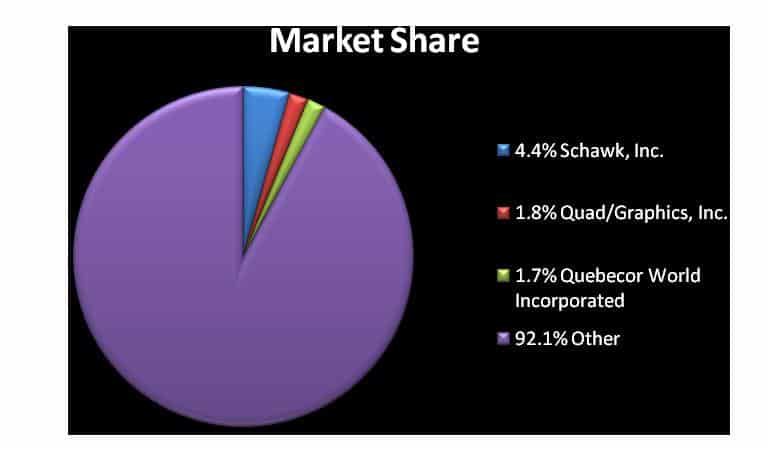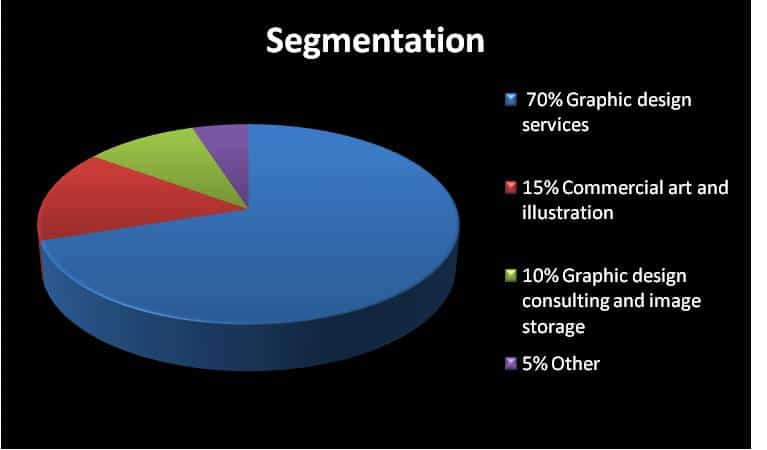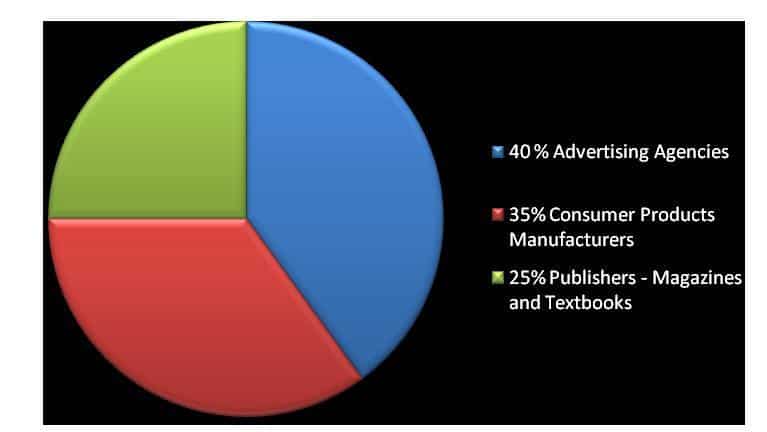NAICS Code: 541430, SIC: 7336
by: Merari Ramos
Entrepreneur.com claims, “If you’ve always pictured yourself as a commercial artist but your drawing style is closer to stick figures than Cézannes, then graphic design might be just the business for you.”1 Since technology is always advancing, especially in this industry, there are many ways to get around the pencil and eraser. Graphic designers may use various types of software to formulate their creative ideas and transform them into a masterpiece.
Some graphic design artists may come up with drawings for advertisements, logos, brochures, product packaging, textbooks, magazines and even mail order catalogs.1 Graphic designers may work on a freelance basis, or they may work in house for a certain company. Potential customers could be corporate clients, advertising agencies, consumer products packaging market and publishers.
Companies in this industry plan, design and manage the production of visual communication in order to convey specific messages or concepts, clarify complex information or project visual identities. “Graphic services do not entail actual printing or production materials, but rather include the various preparatory steps, such as art production design, digital photography, re-touching, color separation and plate making services for use in lithography, flexography and gravure.”2
Demographics
Currently, according to IBIS World, advertising agencies are the largest customer for graphic design services and make up about 40% of the industry’s revenue.2 This particular segment can include independent advertising agencies or in-house advertising departments, and the art work can be displayed on TV, through print, or on the Internet. It is important that the graphic designer takes into account the customer base of the product being advertised in order to convey the most effective message and in the end contribute to the increase of sales for the company.
The second largest market is the products packaging segment, which accumulates around 35% of the revenue.2 Graphic designers in this segment are constantly creating labels in response to social, sporting or musical events depending on the product and their target market. For instance, Gatorade recently promoted the Super Bowl Champs, the Steelers. Since most of these events are for a limited time frame, the product turnaround time and delivery times must be quick. As such, this market segment has higher barriers to market entry than the industry as a whole and is generally performed by large, service integrated companies.2
The third and final major market is the magazine and textbook publishing industry, which provides 25% of graphic design revenue.2 Designers may be employed by publishers to use computer software to create and modify designs, which will be published on books, magazines, and newspapers. 2
Source: 2009 IBISWorld Industry Report 2
Industry Overview
According to Hoovers, Inc, “The US graphic design services industry includes about 16,000 companies with combined annual revenue of $8 billion. No major companies dominate the industry, which is highly fragmented: the 50 largest firms account for less than 20 percent of overall revenue.”3
Competitors
One of the major players in the industry is Schawk Inc.2 In 2008 the company’s annual revenue was $494.2 million and currently has 48 offices worldwide, including the U.S., Canada, Mexico, Europe, and Asia Pacific. The company provides services to various clients whether they may be small or large. Their services are composed of three categories strategic, creative, and executional. For instance they offer brand design, creative retouching, 3D visualization, color management and more. Presently the Company accounts for about 5% of the Graphic Design Services industry.14

Source: 2009 IBISWorld Industry Report 2
The next major competitor is Quad/Graphics Inc. which is the leading company in the world of print. The company employs 11,000 people and earns $2 billion in annual sales. The business prints magazines, direct mail, catalogues and various other items.15 According to IBIS’s report, “It offers a full range of services, including design, photography, desktop production, printing, binding, wrapping and distribution. The company prints catalogs for clients such as Bloomingdale’s and Victoria’s Secret, as well as periodicals such as People, Newsweek, and Sports Illustrated.”2 Even though the company offers a variety of services to well known clients, IBISWorld mentions that Quad/Graphics has a market share of about 2%. In addition, it is very possible that its revenue declined in reference to its graphic design segment.2
Quebecor World Inc. holds its global presence as the largest commercial printers.16 The company has about 20,000 employees in around 90 locations in the U.S., Canada, Argentina, Brazil, Columbia, Chile, Peru and Mexico. The company is composed of printing services for magazine, directories, and book publishers. They also account for their own team of graphic designers to create and develop images way before the printing is actually done. Some of the graphic design services consist of “electronic page makeup, color separations, gravure data preparation, analog and digital proofing, CTP processing and color management. Quebecor also offers clients creative services (such as art direction and design and layout) and conventional, digital and 3-D photographic services.”2 Now its market share in this graphic design segment is a fewer than 2% in comparison to the industry as a whole.
Segmentation
In zooming in on the services and products within the graphic design industry 70% of the revenue accounts solely on the three processes of designing an image which are lithography, flexography and gravure. Smaller companies may focus on just one of these processes, while larger firms have facilities capable of offering all three. 2 As discovered previously, most of the companies providing digital imaging services have the feasibility to provide these services globally.

Source: 2009 IBISWorld Industry Report 2
Commercial art and illustrations is the segment that makes up 15% of the industry.2 Commercial arts consist of original images or replicas for sale and illustrations are mainly used on printed media. Another 10% of the revenue goes to various graphics arts consulting services and storage imaging. Other income accounts for approximately 5% of revenue.2
Industry Trends
Regarding the competitive landscape in the Graphic Design services industry, Hoovers, Inc, states, “Regional economic activity drives demand, because most graphic design firms are small and work locally. The profitability of individual companies depends on accurate bidding, timely delivery of projects, and a steady volume of work. Large companies have advantages in marketing and sales, breadth of services, delivery of complex projects, and supporting ongoing contracts. Small companies can compete effectively by responding quicker, adopting new trends, and specializing by services or markets.”3
Western U.S.
It is documented by Alissa Walker in the article, Far West, that the design firms in the western part of U.S. are remaining small and diversified.4 Several firms are offering a variety of services to respond to the economic downturn. For instance she mentions that, “Bozeman-based Entropy Brands is offering more services, such as commercial production, photography, and custom packaging.”4 The executive creative director for ID Branding in Portland talks about how the company has shifted its focus from buyer-vendor relationships toward partnerships with clients.4
In the article, designer Jessica Fleischmann for Journal of Aesthetics and Protest speaks out her opinion on print. “Print is still the most efficient method for delivering design,” she says. She supports the idea on how print is a great way to show expression.4
Going Green
A dominant trend that is penetrating almost every industry is the concept of being eco-friendly, and graphic design is no exception. Designers are using the idea of sustainable design or green design, which means incorporating social responsibility when designing printed media. Basically keeping in mind and practicing ways to reduce the use of non-renewable resources, decreasing the environmental impact and making sure that no one is being harmed by your action. Jennifer Blais the author of “Going Green Doesn’t Have to Take Much Green,” mentions several steps to promote eco-friendly practices for both print and multimedia designers.
One recommendation: “Switch to papers with a high post-consumer recycled content (non de-inked when possible) and that are also processed chlorine free. Prefer papers that are produced using clean energy such as wind and solar power. By specifying recycled papers, you help reduce the amount of waste in the world which means less landfill; reducing the amount of chlorine means fewer toxins in our water table and rivers; clean energy means less pollution” 5
Another advice includes printing locally to where the piece will be used, printing using local materials, going electronic whenever possible, and minimizing the use of adhesives and inks with strong chemicals.5
In order to inspire the “going green” trend, Agfa Graphics has begun an Environmental Recognition Awards program which recognizes business that use eco-friendly practices. H&S Graphics, “which promotes itself as an ‘Environmentally Friendlier Printing.’”13, is a recipient of this new award. Another award winner was Acell Graphics of London, which is a FSC Certified design and printing facility “that goes to great lengths to promote environmental awareness, in part, by publicizing its own proactive approaches.”12 The Company recycles 99% of all its production materials and uses wind and low-impact hydro-generated power for all of their energy consumption.12
Contracts and Copyrights
Like most contracts, a graphic design contract consists of an offer, acceptance, and consideration. The offer and acceptance may be written, oral, or by conduct.8 “For example, if a publisher from Time magazine delivers a story manuscript to an artist who is aware of the prices paid by the magazine, the assumption is that delivery constitutes an offer to the artist to illustrate the story at those prices. Now the retention of the manuscript by the artist may be construed as acceptance of the offer.” 8
Copyrights are very important for graphic designers to protect their artistic work. In order to defend any art work it must be registered, especially if the image will be seen by the public. Not all work has to have a copyright; the words “cease and desist” can be written on your design. By using this phrase, the author informs the viewers not to use the copyrighted work, even though it has not been registered.13 One can file for a copyright at any time, but cannot legally file an infringement of copyright action unless the work in question is registered.13
Stock Images
Stock photography has been around since the 1920s and was originally used in the newspaper industry.6 It has become very popular among graphic designers and is more accessible than ever before. An easy way to save money might be to visit free stock photography web sites for images. There are also several commercial stock photography services. Some of these firms are composed of marketing, advertising, and media professionals and others have been founded by graphic designers and recognized photographers, who provide a wide range of images for their customers.6
Commercial stock photography services offer the opportunity to become a member and provide free images to customers so they may have a free trial of your work. In addition to the free trial you can sell your designs online. Instead of becoming a member you may prefer to have your own stock website. Stock images are convenient, inexpensive and offer variety for customers. Doug Farrick advises, “You can fulfill a niche with your graphic design to attract targeted buyers. Look for a category that is underrepresented in stock galleries. The trick to having successful stock work is display your work in large gallery with a searchable site. Users must be able to draw up images with different keyword approaches.” 7
Commercial Design
Commercial design is the selling of artwork for promotional purposes. This type of artwork can be created through the same mediums that are used for aesthetic art, such as print, paint, computer software, video cameras and other media. Many of these designs can be seen by the public eye on television, movies, posters, and even billboards.8
Commercial design services are mainly demanded when there is a budget available for these types of projects within private or public firms, or when a specific event is being promoted alongside a product. Many companies partner with events and awareness campaigns to enhance their brand recognition. In developing these images for commercials or packaging, the designer must take into consideration the products target market. The designer must also have good judgment and taste to appeal to its clients and the firm’s consumers.
Technology
Technology has had a significant impact on the graphic design industry. Although the use of paint, pencils, paper, and brushes is still present, the use of the internet and computers has had a great impact. The use of desktop publishing (DTP) has created a new way of designing images. DTP can produce attractive, artistic pages using different typefaces and graphic elements in harmony. One of the pros for using DTP is that even for a small business this could be a very inexpensive way to publish internally. In addition to the use of technology many publishing and advertising agencies are beginning to sell their products online, which is creating a new demand for qualified designers in this segment.2
All you need to do to begin using DTP is a computer with the appropriate software package, a scanner, and a color printer.8 The ideal computer for most graphic designers is the use of Apple Computer’s Mac operating system. The reason for this is because it is user friendly and it has special features and capabilities for graphic designing. These computers can carry large files of video and graphics. Graphic designers may also use specialized software to develop animation, illustrations, interactive media and various layouts to create their ideal design.
Marketing
As in any business, your most important asset is your valuable customers. There are many creative ways to promote your graphic design business, such as word of mouth which is crucial, a business card, social networking, a newsletter, post cards or even emails. The greatest opportunity to begin your clientele is with your first customer, be prepared and have a portfolio ready to demonstrate to them. After this glimpse of your artwork and an impressive presentation of yourself give the client a couple of business cards so this way they can refer you to their colleagues.
Send a Newsletter
Often times when someone asks you if you know of someone who does a certain job or skill, the answer is no, I don’t know of anyone or you are trying to think of the person’s name or business name. As humans we are very busy and we easily forget many events and most likely names. As stated by author, Eric Miller, of the article, Growing Your Graphic Design Business Through Word-of-Mouth, one of the convenient ways to remind your clients about your work is through the use a of a newsletter.9 The newsletter can consist of a link with your newest designs and recent jobs performed. Your contacts could be family, clients, friends, and other designers, but remember to make sure you have their consent to add them to your mailing list.9
Credit Line
Another suggestion made by Miller is to have your own credit line.9 This is an effective way to have your name on your designs; your name should appear in small lettering on your print images. According to Miller, “The best option is to have your web address on a print piece, so people can go directly to your site without having to ask your client for your contact info or Google you and end up at the wrong place. A simple “Designed by myurl.com” will do.”9 Just be creative and try to come up with a unique and catchy name.
A Portfolio
As mentioned previously a portfolio is an excellent tool to show off your artwork. Miller indicates the most successful way to do this is by developing a website portfolio, which has all of your designs and contact information.9 If you are not website savvy, an alternative option would be to purchase templates online. Shaun Crowley, the author of “How to Frugally Market Your Business” states that these templates are accessible at www.templateshome.com and you can purchase one for about $60.10 If you are on a budget, your last resort could be to compile your designs into a PDF portfolio and attach it to any email you wish.
Business Cards
Having a set of business cards handy is a professional way to address yourself to your potential clients. Not only will it have your contact information but Miller also comments that it is a great way to show your design skills. As a graphic designer you can create your business card with a unique touch of style to provide a gist of the type of artwork you do. After you give a couple to your friends and family keep a look out for a phone call or an email!
Postcards
Crowley provides a practical tip; he mentions as you print out your business cards you may also want to print some mailer postcards. Once again this is an opportunity to demonstrate your artistic work. On one side include an illustration of your design work and on the other market your services mentioning the benefits you offer, and also your contact information.
The author, Crowley, also suggests researching the types of companies you will be targeting. He says to aim high because “large corporations with multiple departments make better leads than small or medium-sized businesses.”10 A big company as a client will more than likely have continuous work and could recommend you to other departments within the firm. Make sure to search for companies within driving distance and note their contact information.
After you have conducted your research, begin to create a spreadsheet with all of the companies you plan to target. Crowley suggests, “Build yourself a database of contacts in a spreadsheet including the names, titles, email addresses, mail addresses, and telephone numbers of all key sales and marketing contacts within your target companies.”10 This will be the starting point in your attempt to build up your contacts.
Here comes the exciting part: send out your postcards to all of the addresses you have collected. After a week has passed send a follow up email to each company asking them if they use the services of freelance graphic designer and request a meeting to talk to them about a possible project they have in mind. In the email remember to include a link to your website so they can see your portfolio. Crowley’s suggestion: “If you don’t have a website, ask your contact to reply for samples of your work, then send a maximum of three pdfs or jpegs that total under 2MB (anything over this will be deleted when inboxes get crammed).”10 Now just hope for the best and wait for an interested response.
Emails
Crowley also gives some advice on sending emails to prospect clients which are very helpful. The first is to send a customized email to each client and not a general email to all your contacts at a time; this will be more presentable and professional. The second tip is that your first email should be short, nice and sweet, just introducing yourself and asking for permission to send a couple of your designs. He does state, “Never attach visuals to your introductory email; your email will be deleted as spam.”10 Finally, set up an automatic email signature to offer an easy access to contact you, and follow up with a personal phone call.
Current and Future Outlook
According to the U.S. Bureau of Labor Statistics, the average annual income of graphic designers was $46,750 in 2008.11 By industry, the breakdown is shown below:
| Industry | Annual Mean Wage |
| Specialized design services | $50,190 |
| Newspaper, periodical, book, and directory publishing | $40,680 |
| Advertising and public relations | $48,140 |
| Printing and related support activities | $38,910 |
U.S. Bureau of Labor Statistics11
The Bureau of Labor Statistics expects employment for the graphic design industry to grow about 10% this decade. Although this projection may seem encouraging for designers, IBISWorld projects that between 2009 and 2011 there will be a down slope in growth due to the major players in the industry trying to consolidate for a temporary period, but after this, growth should resume as normal.2
As technology continues to evolve within this industry there is a positive outlook for graphic designers who have experience in using the internet for their projects. IBISWorld mentions that the use of freelance labor and contracts will increase in the process of cutting wage cost. “The adoption of new technology should reduce head count at some firms, although wages for remaining employees are likely to increase as they take on more responsibility and operate more advanced technology.” 2 In the long run, the dark shadow of less expensive labor from Asian designers will be hovering over U.S. designers.
Meanwhile, there will be upcoming events which will generate revenue for the graphic design industry, such as the 2010 soccer World Cup in South Africa and the 2012 Olympics in London. Graphic designers must keep up to date with the latest technology in order to compete, because the use of digital technology and eco friendly techniques are the new trend and graphic design is no exception!
Associations
The Professional Association for Design
American Institute of Graphic Arts – https://www.aiga.org/
Graphics Artists Guild – https://www.graphicartistsguild.org/
Association Typographique Internationale – https://www.atypi.org/
Printing Industries of America – https://www.printing.org/
National Association of Photoshop Professionals – https://www.photoshopuser.com/
Society for Environmental Graphic Design – https://www.segd.org/
Society for News Design – https://www.snd.org/
Art Directors Club – https://www.adcglobal.org/
Art Years – https://www.artyears.com/
Color Association – https://www.colorassociation.com/
Sources
1 Business Idea Center: Graphic Design. Entrepreneur Media, Inc. 2009. 06 Aug 2009 https://aol.entrepreneur.com/businessideas/58.html.
2“Graphic Design Services in the U.S.” May 2009. IBISWorld. Santa Monica: CA. University of Texas at San Antonio, John Peace Library. San Antonio, TX. 13 Aug 2009. www.ibisworld.com
3Hoover’s. Graphic Design Services Industry Description. 2009. Aug 06 <https://www.hoovers.com/graphic-design-services/–ID__259–/free-ind-fr-profile-basic.xhtml>.
4 Walker, Alissa. “FAR WEST.” F&W Media, Inc. Vol. 62 Issue 6 (Dec. 2008): p48-49, 2p. Academic Search Complete. EBSCO. University of Texas at San Antonio, John Peace Library. San Antonio, TX. 13 Aug 2009
5Blais, Jennifer. “Going Green Doesn’t Have to Take Much Green.” Graphic Define Magazine.08 Sep 2009 <https://www.graphicdefine.org/issue3/goinggreen>
6Wilkerson, Jourdan. “Free and Commercial Stock Photography Sites.” Smashing Magazine. August 16th, 2009. 13 Aug 2009 < https://www.smashingmagazine.com/2009/08/16/free-and-commercial-stock-photography-sites/>.
7Farrick. Doug. “Cash Out on Graphic Design Licenses.” CreativePublic. 2000-2009. August 19, 2009 <https://www.creativepublic.com/graphic-design-licenses.php>.
8“SIC 7336 Commercial Art and Graphic Design.” Encyclopedia of American Industries. 5th ed. Detroit: Gale, 2008. Gale Virtual Reference Library. Gale. Univ of Texas at San Antonio. 10 Aug. 2009 <https://go.galegroup.com/ps/start.do?p=GVRL&u=txshracd2604>.
9Miller, Eric. “Graphic Design Business Ideas and Tips.” About.com. 18 Aug 2009 <https://graphicdesign.about.com/od/career/tp/word_of_mouth.htm>.
10Crowley, Shaun. “Part 1: How to Frugally Market Your Business.” Freelance Switch. 2007. Aug 19 2009 <https://freelanceswitch.com/designer/how-to-promote-your-graphic-design-business-%E2%80%93-part-one/>.
11U.S. Bureau of Labor Statistics. “Occupational Employment and Wages, May 2008.” 04 May 2009. 19 Aug 2009 <https://www.bls.gov/oes/current/oes271024.htm>.
12Kaye, Gordon. “Thinking Green – Recognition to Inspire.” Green Design Graphic Design USA ENEWSLETTER. November 2007. 08 Sep 2009 <https://www.gdusa.com/egdusa/pages/071115-green.html>
13Jackson, Chris. “Do I need a Copyright?” CreativePublic. 2000-2009. Sep 8 2009 <https://www.creativepublic.com/copyright.php>
14“Schawk.” Fast Facts. 2009. 01 September 2009 < https://www.schawk.com/about-us/fast-facts>.
15“QuadGraphics.” About Quad/Graphics. 2009. 01 September 2009 <https://www.qg.com/aboutus/about_qg.asp>
16“Quebecor World.” About Us Discover Quebecor World. 2009. 01 September 2009 < ;
SBDCNet distributes limited competitor and/or supplier lists from industry accepted resources, but cannot guaranty accuracy. SBDCNet does not provide marketing lists, medical or legal advice. Preliminary patent and trademark searches do not constitute legal advice and consultation with an intellectual property attorney is advised. This material is based upon work supported by the U.S. Small Business Administration. Any opinions, findings, conclusions or recommendations expressed are those of SBDCNet and do not necessarily reflect the views of the U.S. SBA. This U.S. Small Business Administration (SBA) Grant is funded by the SBA. SBA’s funding is not an endorsement of any products, opinions, or services. All SBA funded programs are extended to the public on a nondiscriminatory basis. This material may be protected by Copyright law (Title 17 U.S. Code).
Photo by Krisztian Tabori on Unsplash







